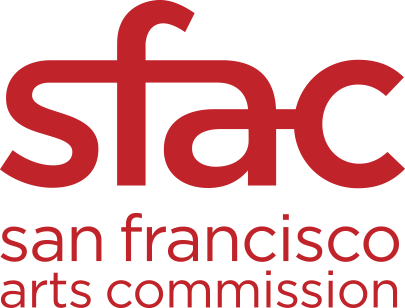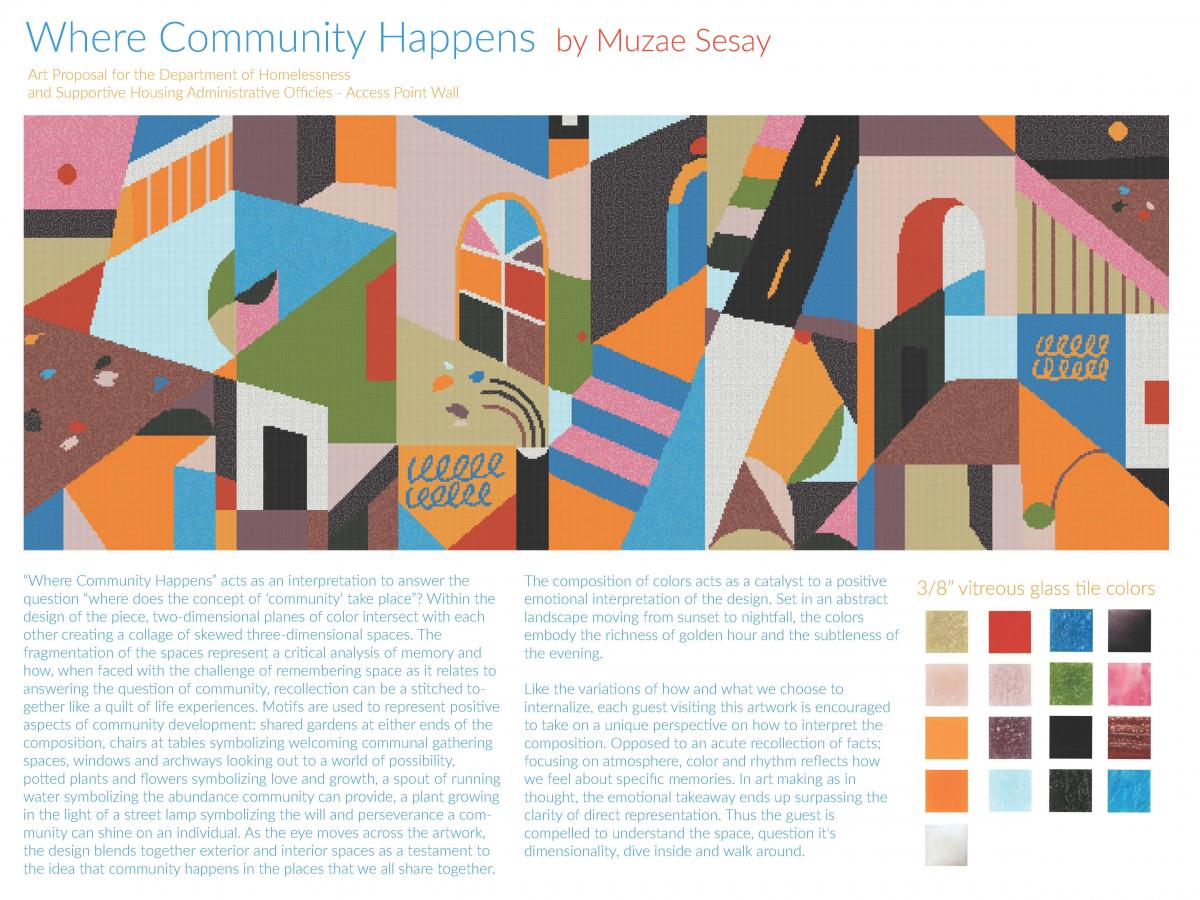Public Art Proposal Display
Art Proposals for the the Department of Homelessness and Supportive Housing Administrative Offices Public Art Project
The San Francisco Arts Commission is conducting a selection process to choose an artwork for the Department of Homelessness and Supportive Housing’s new Administrative Offices and Client Access Point at 440 Turk Street. The project involves the remodel of an existing building at 440 Turk for the purposes of serving as administrative offices for the Department of Homelessness and Supportive Housing (HSH), and providing certain client services. The goal is to create a signature artwork for the Access Point wall that will create an atmosphere of dignity and respect, and follows the principles of “evidence based art” by being supportive to clients experiencing stress, symptoms of mental illness, and other negative impacts of homelessness. Three artists were chosen as finalists by a Selection Panel to create site-specific proposals for the new Department of Homelessness and Supportive Housing Access Point wall: Johanna Poethig, Eric Rewitzer, and Muzae Sesay.



 The restorative qualities of water as it ripples out in a soft movement, the grace of water lilies and the algorithmic beauty of plant growth patterns come together in this composition. The Access Point Wall is located in an interior space so my aim is to bring a luminous landscape to brighten the room and lift the spirits of the people who come for services at HSH as well as for the staff who work there. The colors are bright with greens and blues of the water and lily pads along with light pinks, creamy whites and splashes of yellow and orange of the flowers and
The restorative qualities of water as it ripples out in a soft movement, the grace of water lilies and the algorithmic beauty of plant growth patterns come together in this composition. The Access Point Wall is located in an interior space so my aim is to bring a luminous landscape to brighten the room and lift the spirits of the people who come for services at HSH as well as for the staff who work there. The colors are bright with greens and blues of the water and lily pads along with light pinks, creamy whites and splashes of yellow and orange of the flowers and As an artist and resident of San Francisco, this project has been a rewarding and revealing journey. I was deeply moved by the time spent in the Tenderloin with both Del Seymore and again with the artists at Hospitality House. If not for being considered for this project, I would not have been exposed to the level of compassion and resilience that are as present as the more obvious issues around homelessness in San Francisco. Thank you for this opportunity to learn more about my City and my community.
As an artist and resident of San Francisco, this project has been a rewarding and revealing journey. I was deeply moved by the time spent in the Tenderloin with both Del Seymore and again with the artists at Hospitality House. If not for being considered for this project, I would not have been exposed to the level of compassion and resilience that are as present as the more obvious issues around homelessness in San Francisco. Thank you for this opportunity to learn more about my City and my community. Where Community Happens acts as an interpretation to answer the question “where does the concept of ‘community’ take place”? Within the design of the piece, two-dimensional planes of color intersect with each other creating a collage of skewed three-dimensional spaces. The fragmentation of the spaces represent a critical analysis of memory and how, when faced with the challenge of remembering space as it relates to answering the question of community, recollection can be a stitched together like a quilt of life experiences. Motifs are used to represent positive aspects of community development: shared gardens at either ends of the composition, chairs at tables symbolizing welcoming communal gathering spaces, windows and archways looking out to a world of possibility, potted plants and flowers symbolizing love and growth, a spout of running water symbolizing the abundance community can provide, a plant growing in the light of a street lamp symbolizing the will and perseverance a community can shine on an individual. As the eye moves across the artwork, the design blends together exterior and interior spaces as a testament to the idea that community happens in the places that we all share together.
Where Community Happens acts as an interpretation to answer the question “where does the concept of ‘community’ take place”? Within the design of the piece, two-dimensional planes of color intersect with each other creating a collage of skewed three-dimensional spaces. The fragmentation of the spaces represent a critical analysis of memory and how, when faced with the challenge of remembering space as it relates to answering the question of community, recollection can be a stitched together like a quilt of life experiences. Motifs are used to represent positive aspects of community development: shared gardens at either ends of the composition, chairs at tables symbolizing welcoming communal gathering spaces, windows and archways looking out to a world of possibility, potted plants and flowers symbolizing love and growth, a spout of running water symbolizing the abundance community can provide, a plant growing in the light of a street lamp symbolizing the will and perseverance a community can shine on an individual. As the eye moves across the artwork, the design blends together exterior and interior spaces as a testament to the idea that community happens in the places that we all share together.
Opportunity For Public Comment
Please take a few minutes to review these artwork proposals and provide feedback on the public comment forms below. Public comments will be considered by the Selection Panel as part of the Final Selection Panel meeting where the Panel will recommend one proposal for implementation. Please note that public comments do not constitute a vote.
The Final Selection Panel meeting will take place Thursday, April 25, 2019, 1 p.m.–5:00 p.m. at 401 Van Ness Avenue, Room 302. All Artist Selection Panel meetings are open to the public. An agenda for the meeting will be posted at least 72 hours in advance of the meeting on SFAC’s website under the Public Meeting section: www.sfartscommission.org